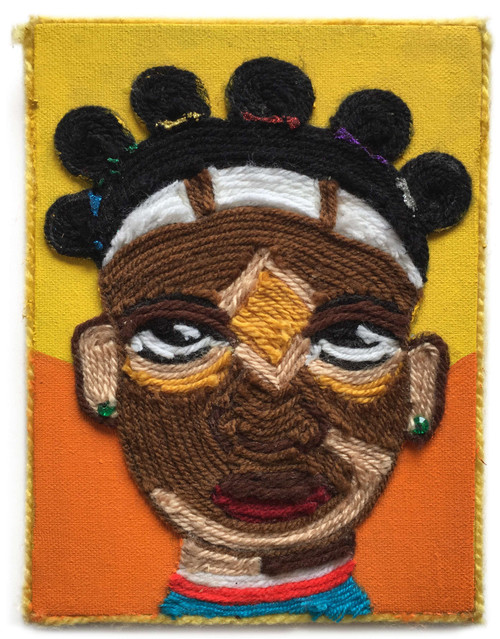Nzuji de Magalhaes

Born and raised in Angola and obtaining advanced education in the United States, Nzuji De Magalhaes had the opportunity to learn and study two essential perspectives of her diverse cultural background. She meticulously combines Angolan and American art forms to convey issues of stereotypes, myths, ethnicity, and politics. In Angola, story-telling was instrumental for spending quality time with family and conveying important lessons along to youth regarding experiences in their daily lives. Although De Magalhaes was taught basic painting and design techniques at school, she acquired her craft skills from her grandfather and uncles. She began to add materials to her artwork as a way to communicate her Angolan culture. Her education continued on American soil. When she arrived in California over twenty years ago, De Magalhaes was fascinated with its diverse culture. She learned the history and events that contributed to its development, especially those referring to her own African American heritage. However, on several occasions, many of her associates have conveyed certain misconceptions and stereotypes about both Africa and African Americans.
For example, in her Souvenirs series De Magalhaes uses sand, beads, yarn, and glitter to capture the traditional Angolan art form while emphasizing the harsh life in her country during an endless civil war between two political parties. These works reflect on tourism and how financial gain from foreign escapists contribute to a country’s domestic turmoil. By selling misguided images of their own ethnic background to tourists, Angolan vendors help perpetuate misconceptions in an effort to survive. In current artwork, De Magalhaes comments on the many foreign companies coming onto African shores to exploit its natural resources. Companies such as Chevron, Texaco, and Fina take petroleum and minerals for their own financial gain. Instead of providing self-sufficient resources such as education and technology to the people, bundles of military weapons, fortified powder milk such as Nestle Nido milk, and second-hand clothing are given as gifts. Angolan cultural structure slowly lessens with the bombardment of Portuguese, American, and now Chinese influences. In her artwork, different fabric patterns represent these influences and are intertwined with symbolic African patterns. Within the bundles of local and foreign objects, the people become objects as well.
De Magalhaes received a Master of Fine Arts in Studio Art from the University of Southern California (USC). Her artwork has been exhibited at the Studio Museum in Harlem New York, MOAD Museum in San Francisco California, and the Hammer Museum’s “Made in LA” Biennial exhibition. Her artwork also expands beyond the gallery and museums. Eight of her oil painted fabric and beaded paintings were translated into a large-scale ceramic mosaic and permanently installed at the Bundy and Exposition Metro line in Santa Monica California. Her painting students at the Los Angeles Harbor College and Art students at Cypress College and Long Beach City College learn how to utilize their skills to create art that conveys their unique ideas. She works with a diverse group of students with varied ethnic and racial backgrounds, abilities, and orientations.
![]() View images from Nzuji de Magalhaes' 2021 exhibition, Bare Recognition.
View images from Nzuji de Magalhaes' 2021 exhibition, Bare Recognition.







